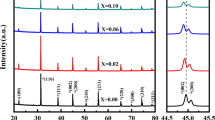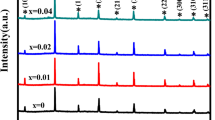Abstract
The effects of ionic doping in Bi0.5Na0.5TiO3 (BNT) ceramics were investigated. Pure and doped BNT samples containing 0 to 16 at.% Ba2+ and 0 to 1.0 at.% Ce4+ were synthesized at 1135 to 1200 °C for 2 h in ambient atmosphere. Temperature dependences of dielectric properties were analyzed. These results suggest that Ba2+ and Ce4+ replace the ions in A and B sites of perovskite structures, and the lattice structure is altered. The component differences of each crystal domain lead to variance of phase transition temperature, which enhances the relaxation character in BNT ceramics, and the dielectric properties were consequently improved.
Similar content being viewed by others
References
X.Z. Jing, Y.X. Li, and Q.R. Yin: Hydrothermal synthesis of Na0.5Bi0.5TiO3 fine powders. Mater. Sci. Eng., B 99, 506 (2003).
Z.P. Cao, A.L. Ding, X.Y. He, W.X. Cheng, and P.S. Qiu: Optical properties of BNT thin films grown on Pt/Ti/SiO2/Si (1 0 0) substrates by a CSD processing. J. Cryst. Growth 270, 168 (2004).
J.R. Gomah-Pettry, S. Senda, P. Marchet, and J.P. Mercurio: Sodium-bismuth titanate based lead-free ferroelectric materials. J. Eur. Ceram. Soc. 24, 1165 (2004).
S. Senda and J.P. Mercurio: Relaxor behaviour of low lead and lead free ferroelectric ceramics of the Na0.5Bi0.5TiO3-PbTiO3 and Na0.5Bi0.5TiO3-K0.5Bi0.5TiO3 systems. J. Eur. Ceram. Soc. 21, 1333 (2001).
H. Nagata and T. Takenaka: Additive effects on electrical properties of (Bi1/2Na1/2)TiO3 ferroelectric ceramics. J. Eur. Ceram. Soc. 21, 1299 (2001).
Y.H. Lin, S.J. Zhao, N. Cai, J.B. Bo, X.S. Zhou, and C.W. Nan: Effects of doping Eu2O3 on the phase transformation and piezoelectric properties of Bi0.5Na0.5TiO3-based ceramics. Mater. Sci. Eng., B 99, 449 (2003).
T. Kimura, T. Takahashi, T. Tani, and Y. Saito: Preparation of crystallographically textured Bi0.5Na0.5-BaTiO3 ceramics by reactive-templated grain growth method. Ceram. Int. 30, 1161 (2004).
A.N. Soukhojak, H. Wang, G.W. Farrey, and Y.M. Chiang: Superlattice in single crystal barium-doped sodium bismuth titanate. J. Phys. Chem. Solids 61, 301 (2000).
T. Takenaka, K. Maruyama, and K. Sakaya: (Bi1/2Na1/2)TiO3-BaTiO3 system for lead-free piezoelectric ceramics. Jpn. J. Appl. Phys. 30, 9B (1991).
Y. Chiang, G.W. Farrey, and A.N. Soukhojak: Lead-free high-strain single-crystal piezoelectrics in the alkaline-bismuth-titanate perovskite family. Appl. Phys. Lett. 73, 25 (1988).
H. Yilmaz, G.L. Messing, and S.T. Mckinstry: (Reactive) Templated grain growth of textured sodium bismuth titanate (Na1/2Bi1/2 TiO3-BaTiO3) ceramics-I processing. J. Electroceram. 11, 3 (2003).
Q. Xu, S.T. Chen, W. Chen, S.J. Wu, J.H. Lee, J. Zhou, H.J. Sun, and Y.M. Li: Structure, piezoelectric properties and ferroelectric properties of (Na0.5Ti0.5)w1−xBaxTiO3 system. J. Alloys Compd. 381, 221 (2004).
B.J. Chu, D.R. Chen, G.R. Li, and Q.R. Yin: Electrical properties of Na1/2Bi1/2TiO3-BaTiO3 ceramics. J. Eur. Ceram. Soc. 22, 2115 (2002).
E. Sentürk: Dielectric characteristics of a Ce3+-doped Sr0.61Ba0.39Nb2O6 single crystal with Cole-Cole plots technique. J. Solid State Chem. 177, 1508 (2004).
J. Fousek and L.E. Cross: Domain-related problem of ferroelectric ceramics. Ceram. Int. 30, 1169 (2004).
L.T. Li: Development of ferroelectric relaxor ceramics. J. Chin. Ceram. Soc. 20, 476 (1992).
N.X. Zhang, Z.L. Gui, and L.T. Li: Non-destructive investigation of microstructure evolution due to ferroelectric fatigue in PLZT ceramics. Mater. Lett. 56, 244 (2002).
P. Pookmanee, G. Rujijanagul, S. Ananta, R.B. Heimann, and S. Phanichphant: Effect of sintering temperature on microstructure of hydrothermally prepared bismuth sodium titanate ceramics. J. Eur. Ceram. Soc. 24, 517 (2004).
S.B. Cho, J.S. Noh, M.M. Lencka, and R.E. Riman: Low temperature hydrothermal synthesis and formation mechanism of lead titanate (PbTiO3) particles using tetramethylammonium hydroxide: Thermodynamic modelling and experimental verification. J. Eur. Ceram. Soc. 23, 2323 (2003).
Author information
Authors and Affiliations
Corresponding author
Rights and permissions
About this article
Cite this article
Shan, D., Qu, Y. & Song, J. Ionic doping effects on crystal structure and relaxation character in Bi0.5Na0.5TiO3 ferroelectric ceramics. Journal of Materials Research 22, 730–734 (2007). https://doi.org/10.1557/jmr.2007.0082
Received:
Accepted:
Published:
Issue Date:
DOI: https://doi.org/10.1557/jmr.2007.0082




